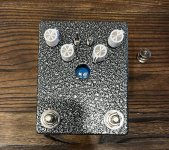PedalBuilder
Well-known member
- Build Rating
- 5.00 star(s)
About a year ago, after lurking in the Bring out yer Diptrace thread, I decided to dabble in making my own PCBs for circuits that Robert was not offering for sale. Many boards later, I decided to take the plunge and try cloning the Spaceman Sputnik II/III. It took quite a bit of on and off again work over about six months, but I'm happy to say that it worked!
I had always been intrigued by the Spaceman Sputnik family of fuzzes, but was a little put off by the side-mounted jacks (and a few other minor things), so it seemed like a good candidate for a DIY build. I initially considered buying a PCB, but after an unpleasant experience building a Gemini IV clone on a commercial PCB that did not seem to be designed to fit in an enclosure that also had jacks, I decided to go it alone and do the PCB myself.
Before I began, I breadboarded the circuit and checked: (1) whether I liked the circuit enough to go to the effort of building one; (2) if yes, whether I wanted the low filter control from the Sputnik II or just the high filter control from the Sputnik III; (3) whether I wanted the diode reverse switch from the DeadEndFX's Laika; and (4) what transistors I would use. I quickly decided that I loved the circuit, the low filter switch was a must-have, and I did not like the diode reverse switch.
I tried a four different low leakage, mid-gain Soviet transistors: GT308V, GT309B, GT310B, and P416B. To my knowledge, the current Spaceman Sputnik III uses the GT308V and P416B, but I decided to expand my search to the 309 and 310 because they had generally similar specs in terms of hFE and leakage. To my surprise, there was a very noticeable difference in tone among the different transistors, even when the gains, leakage, and voltages were essentially identical. Not sure why, but I heard what I heard. Anyway, after a bunch of testing, I settled on the GT310B, which had a somewhat clearer midrange to my ears and was less prone to sounding muddy at certain settings of the filter controls. The hFEs were 68, 86, and 83 for Q1-3, respectively, with leakage under 15µA for each one. For Q4, I used a MMBFJ201 on an adapter board that I had bought from Aion Electronics a while back for another project that I hadn't gotten around to building. I initially planned on using a through hole 2SK30A and designed the PCB accordingly, but the 2SK30As did not sound as good as the MMBFJ201, so I ended up removing the 2SK30A and subbed in the J201. Lastly, for the germanium diode, I used a D9E which my old Craftsman DMM measured as having a Vf of .28 volts. Everything else came from Tayda.
After settling on the audio circuit, I then thought about the other features that I would want the pedal to have. I hate side-mounted jacks, so top-mounted jacks were a requirement. I'm also a big believer in over-voltage protection in addition to reverse polarity protection. The GT310B has a relatively low Vce of 10v and there are trimmers on the collectors of Q1 and Q2, so over-voltage protection was added to the list. Also added to the list:
Anyway, after settling on the list, I went through a bunch of different revisions in EasyEDA with different types of potentiometers, board outlines, breakout boards, etc. I won't go into the details, but it took a while before I settled on this:
Schematic:
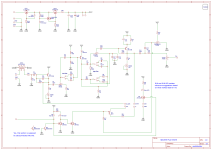
PCB:
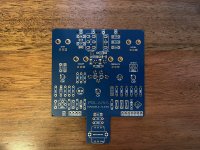
The Sputnik uses an expanded Millennium bypass circuit to simultaneously bypass the pedal and ground the gate of the feedback loop's JFET. I initially considered changing the circuit to use a standard bypass, but ultimately decided against it, after realizing that I could add a MOSFET (Q5 in the schematic) that would turn off the feedback LED when the pedal was bypassed. I also decided that to use JLCPCB's assembly service for the bypass switching transistors, most of the polarity/over-voltage protection circuit, and a couple of random passive components (because why not?).
For the enclosure, I opted for a 1590BB2 from Tayda in the silver hammer finish (I think Spaceman calls this "Meteorite"). Whatever you want to call it, I think it looks pretty cool:

(For those who are curious, the footswitches are these ones from Antique Electronic Supply. I added the oversized washers myself.)
When you think about the aesthetic of the Spaceman pedals, the first thing that probably comes to mind is the use of acrylic faceplates. I designed mine in Adobe Illustrator and had it made by Spencer at @amplifyfun. Needless to say, it turned out really well.
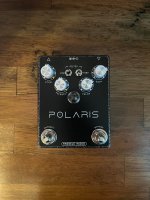
And the obligatory gut shot:
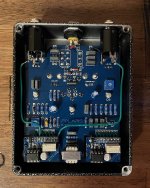
So, how does it sound? If you've heard a demo, those are a very good indicator of how it sounds. It reminds me a lot of the Tone Bender Mk. III family when it's running at higher fuzz settings, but it does a better job of cleaning up with the volume knob than any of the Mk. III-type fuzzes that I've played. The gain control goes from a dark, fuzzy light overdrive all the way to face-melting fuzz. The filter knob has a lot of cool sounds from one end of the dial to the other, with genuinely useful tones across the sweep. Does the pedal doom? Yes, it does. Does it do Ziggy Stardust? Also yes. What about chimey cleans when you roll down the volume knob? It does that, too. The filter switches have a subtle, but still noticeable effect when the pedal is operating in normal mode, and a massive effect when the pedal is in feedback mode. The feedback mode initially seemed to be a cool gimmick, something that you might do once and a while at the end of a solo, but otherwise something that would go unused. After playing with it for a while, it's actually a much more versatile tool. It can do blasts of feedback, but when the feedback knob is set just at the edge of oscillation, it lets you get a lot of interesting textures—ring modulation suboctaves, glitchy gated fuzz, smooth synth tones, and other sounds that I don't know how to describe. It's a ton of fun to play and is a great creative tool IMHO. Building it was definitely a learning experience, but I'm very happy with how it turned out.
I had always been intrigued by the Spaceman Sputnik family of fuzzes, but was a little put off by the side-mounted jacks (and a few other minor things), so it seemed like a good candidate for a DIY build. I initially considered buying a PCB, but after an unpleasant experience building a Gemini IV clone on a commercial PCB that did not seem to be designed to fit in an enclosure that also had jacks, I decided to go it alone and do the PCB myself.
Before I began, I breadboarded the circuit and checked: (1) whether I liked the circuit enough to go to the effort of building one; (2) if yes, whether I wanted the low filter control from the Sputnik II or just the high filter control from the Sputnik III; (3) whether I wanted the diode reverse switch from the DeadEndFX's Laika; and (4) what transistors I would use. I quickly decided that I loved the circuit, the low filter switch was a must-have, and I did not like the diode reverse switch.
I tried a four different low leakage, mid-gain Soviet transistors: GT308V, GT309B, GT310B, and P416B. To my knowledge, the current Spaceman Sputnik III uses the GT308V and P416B, but I decided to expand my search to the 309 and 310 because they had generally similar specs in terms of hFE and leakage. To my surprise, there was a very noticeable difference in tone among the different transistors, even when the gains, leakage, and voltages were essentially identical. Not sure why, but I heard what I heard. Anyway, after a bunch of testing, I settled on the GT310B, which had a somewhat clearer midrange to my ears and was less prone to sounding muddy at certain settings of the filter controls. The hFEs were 68, 86, and 83 for Q1-3, respectively, with leakage under 15µA for each one. For Q4, I used a MMBFJ201 on an adapter board that I had bought from Aion Electronics a while back for another project that I hadn't gotten around to building. I initially planned on using a through hole 2SK30A and designed the PCB accordingly, but the 2SK30As did not sound as good as the MMBFJ201, so I ended up removing the 2SK30A and subbed in the J201. Lastly, for the germanium diode, I used a D9E which my old Craftsman DMM measured as having a Vf of .28 volts. Everything else came from Tayda.
After settling on the audio circuit, I then thought about the other features that I would want the pedal to have. I hate side-mounted jacks, so top-mounted jacks were a requirement. I'm also a big believer in over-voltage protection in addition to reverse polarity protection. The GT310B has a relatively low Vce of 10v and there are trimmers on the collectors of Q1 and Q2, so over-voltage protection was added to the list. Also added to the list:
- Strain relief holes for the DC jack and ground wires from the audio jacks
- Intelligent relay bypass switching including:
- Tap to toggle state, hold for momentary engage/disengage
- Selectable auto-on, auto-off, remember on/off for the main bypass
- Selectable momentary on and tap/hold for the feedback circuit footswitch
- Courtesy 9v outputs for the relay bypass boards
- Analog switching to turn off the feedback indicator LED when the pedal was bypassed
- A visually-catching control layout like the Sputnik III
Anyway, after settling on the list, I went through a bunch of different revisions in EasyEDA with different types of potentiometers, board outlines, breakout boards, etc. I won't go into the details, but it took a while before I settled on this:
Schematic:

PCB:

The Sputnik uses an expanded Millennium bypass circuit to simultaneously bypass the pedal and ground the gate of the feedback loop's JFET. I initially considered changing the circuit to use a standard bypass, but ultimately decided against it, after realizing that I could add a MOSFET (Q5 in the schematic) that would turn off the feedback LED when the pedal was bypassed. I also decided that to use JLCPCB's assembly service for the bypass switching transistors, most of the polarity/over-voltage protection circuit, and a couple of random passive components (because why not?).
For the enclosure, I opted for a 1590BB2 from Tayda in the silver hammer finish (I think Spaceman calls this "Meteorite"). Whatever you want to call it, I think it looks pretty cool:

(For those who are curious, the footswitches are these ones from Antique Electronic Supply. I added the oversized washers myself.)
When you think about the aesthetic of the Spaceman pedals, the first thing that probably comes to mind is the use of acrylic faceplates. I designed mine in Adobe Illustrator and had it made by Spencer at @amplifyfun. Needless to say, it turned out really well.

And the obligatory gut shot:

So, how does it sound? If you've heard a demo, those are a very good indicator of how it sounds. It reminds me a lot of the Tone Bender Mk. III family when it's running at higher fuzz settings, but it does a better job of cleaning up with the volume knob than any of the Mk. III-type fuzzes that I've played. The gain control goes from a dark, fuzzy light overdrive all the way to face-melting fuzz. The filter knob has a lot of cool sounds from one end of the dial to the other, with genuinely useful tones across the sweep. Does the pedal doom? Yes, it does. Does it do Ziggy Stardust? Also yes. What about chimey cleans when you roll down the volume knob? It does that, too. The filter switches have a subtle, but still noticeable effect when the pedal is operating in normal mode, and a massive effect when the pedal is in feedback mode. The feedback mode initially seemed to be a cool gimmick, something that you might do once and a while at the end of a solo, but otherwise something that would go unused. After playing with it for a while, it's actually a much more versatile tool. It can do blasts of feedback, but when the feedback knob is set just at the edge of oscillation, it lets you get a lot of interesting textures—ring modulation suboctaves, glitchy gated fuzz, smooth synth tones, and other sounds that I don't know how to describe. It's a ton of fun to play and is a great creative tool IMHO. Building it was definitely a learning experience, but I'm very happy with how it turned out.
Attachments
Last edited:


